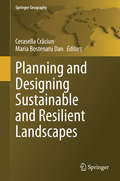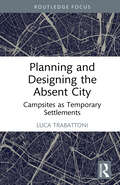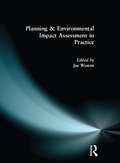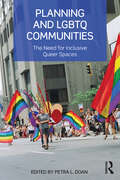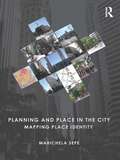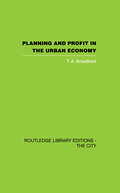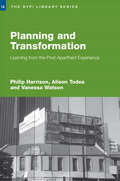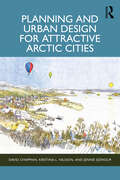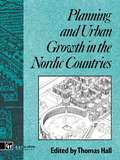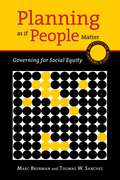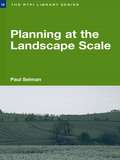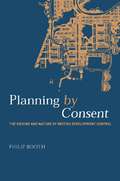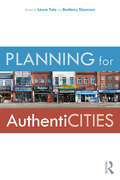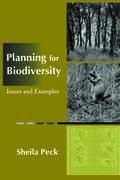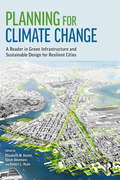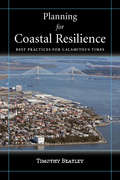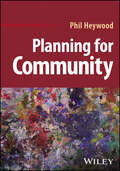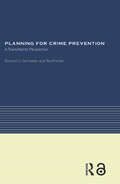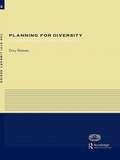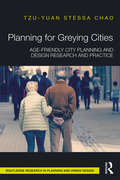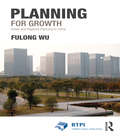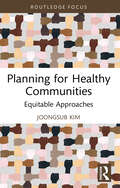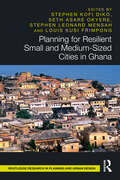- Table View
- List View
Planning and Designing Sustainable and Resilient Landscapes
by Cerasella Crăciun Maria Bostenaru DanThis book deals with planning issues in landscape architecture, which start at the evaluation of the existing fabric of society, its history and memory, approached and conserved through photography, film and scenographic installations, a way in which the archetypes can be investigated, be it industrial derelict sites or already green spaces and cultural landscapes. It provides approaches to intervention, through rehabilitation and upgrade, eventually in participative manner. To such evaluation and promotion a couple of disciplines can contribute such as history of art, geography and communication science and of course (landscape) architecture. The field of landscape architecture reunites points of view from such different disciplines with a view to an active approach a contemporary intervention or conservation. The book presents case studies from several European countries (Romania, Germany, Austria, Italy, Portugal) mostly for large landscape in the outskirts of the cities and in the parks.
Planning and Designing the Absent City: Campsites as Temporary Settlements
by Luca TrabattoniThis book concerns the study of open-air accommodation facilities. The market evolutions allow us to look at these structures as temporary settlements characterised by a low-density dwelling and a close connection with natural elements and the landscape.This new and different point of view is sustained by the tendency of outdoor tourism to go in the direction of temporary villages, and this tendency is directly related to "time" and "landscape". The landscape is the reason why the campsite is settled. The time is linked to the holiday season timing. Today, both are greatly influenced by the introduction of the "Maxi-Caravan". This removable living unit can be placed on the empty pitch, occupying the landscape without ruining the soil. By the settlement of Maxi-Caravans, the campsite is transformed from an empty landscape with tents to a temporary settlement, whose timing is divided between the seasonal timing of the campsite and the "timing" of the product, and whose landscape is organised by the relation with the prevalent landscape and the internal one. The book's core defines the outdoor facility structure, using Italy as the main case study. To identify design strategies, the book analyses temporary settlement examples (quick time) and projects from historic outdoor tourism (medium time). Finally, the last chapter reflects on open-air accommodation facilities by showing their applicability in the different contexts of the refugee camps (long time).The aim of this research is to enhance the theme of open-air accommodation facilities, highlighting the need to equalise the study of temporary settlements with that of permanent settlements. It will be of interest to researchers and students of planning, landscape and tourism.
Planning and Environmental Impact Assessment in Practice
by Joe WestonEnvironmental Impact Assessment (EIA) is a fast-growing field of land-use planning affecting many disciplines. At present, UK Government legislation requires EIA for certain types of development. Subject to a further new European directive, an EIA will be required for all policies, plans and programmes. Planning and Environmental Impact Assessment in Practice provides a practical introduction to the subject and relates the theory to the practice through extensive use of case studies. Edited by Joe Weston, the book draws on contributions from a number of practising experts in the field and covers topics such as: assessing the need for EIAs; the environmental team; scoping and public participation; internal and external consultation; local lobbying; local authority review and decision-making; public enquiries; monitoring the impacts; pollution control; and the lessons to be learned. Planning and Environmental Impact Assessment in Practice provides a practical introduction to EIA for final year undergraduate and postgraduate MSc courses in planning, geography, civil engineering, building and estate management, and development.
Planning and Housing in the Rapidly Urbanising World (Housing, Planning and Design Series)
by Harry Smith Paul Jenkins Ya Ping WangWritten specifically as a teaching text and authored by a team of leading academics in the field, this is the first book to bring together the key issues of rapid urbanisation with approaches to planning and housing. Outlining and explaining core concepts from ‘informal settlements’ to ‘sustainability’, it focuses on the rapid urbanization of developing countries with case studies from Latin America, Asia and Sub-Saharan Africa. The impact of rapid urbanization and associated globalization on land-use and housing is described and analyzed with reference to the particular issues of poverty, health and the environment of these areas. Providing an accessible introduction to the key issues as well as enhancing current theoretical debates and exploring practical applications, this book is an essential resource for students and researchers in this area.
Planning and LGBTQ Communities: The Need for Inclusive Queer Spaces
by Petra L. DoanAlthough the last decade has seen steady progress towards wider acceptance of lesbian, gay, bisexual, transgendered, and queer (LGBTQ) individuals, LGBTQ residential and commercial areas have come under increasing pressure from gentrification and redevelopment initiatives. As a result many of these neighborhoods are losing their special character as safe havens for sexual and gender minorities. Urban planners and municipal officials have sometimes ignored the transformation of these neighborhoods and at other times been complicit in these changes. Planning and LGBTQ Communities brings together experienced planners, administrators, and researchers in the fields of planning and geography to reflect on the evolution of urban neighborhoods in which LGBTQ populations live, work, and play. The authors examine a variety of LGBTQ residential and commercial areas to highlight policy and planning links to the development of these neighborhoods. Each chapter explores a particular urban context and asks how the field of planning has enabled, facilitated, and/or neglected the specialized and diverse needs of the LGBTQ population. A central theme of this book is that urban planners need to think "beyond queer space" because LGBTQ populations are more diverse and dispersed than the white gay male populations that created many of the most visible gayborhoods. The authors provide practical guidance for cities and citizens seeking to strengthen neighborhoods that have an explicit LGBTQ focus as well as other areas that are LGBTQ-friendly. They also encourage broader awareness of the needs of this marginalized population and the need to establish more formal linkages between municipal government and a range of LGBTQ groups. Planning and LGBTQ Communities also adds useful material for graduate level courses in planning theory, urban and regional theory, planning for multicultural cities, urban geography, and geographies of gender and sexuality.
Planning and Place in the City: Mapping Place Identity
by Marichela SepeUnder the influence of globalization, the centres of many cities in the industrialised world are losing their place identity, the set of cultural markers that define a city’s uniqueness and make it instantly recognisable. A key task for planners and residents, working together, is to preserve that unique sense of place without making the city a parody of itself. In Planning and Place in the City, Marichela Sepe explores the preservation, reconstruction and enhancement of cultural heritage and place identity. She outlines the history of the concept of placemaking, and sets out the range of different methods of analysis and assessment that are used to help pin down the nature of place identity. This book also uses the author's own survey-based method called PlaceMaker to detect elements that do not feature in traditional mapping and identifies appropriate planning interventions. Case studies investigate cities in Europe, North America and Asia, which demonstrate how surveys and interviews can be used to draw up an analytical map of place identity. This investigative work is a crucial step in identifying cultural elements which will influence what planning decisions should be taken in the future. The maps aim to establish a dialogue with local residents and support planners and administrators in making sustainable changes. The case studies are amply illustrated with survey data sheets, photos, and coloured maps. Innovative and broad-based, Planning and Place in the City lays out an approach to the identification and preservation of place and cultural heritage suitable for students, academics and professionals alike.
Planning and Profit in the Urban Economy
by T.A. BroadbentFirst Published in 2006. This text tries to answer some of the questions posed in the introduction to the British edition of 'After the Planners'- what is the relationship between government and industry and what is the role of planning within his relationship.
Planning and Transformation: Learning from the Post-Apartheid Experience (RTPI Library Series)
by Vanessa Watson Alison Todes Philip HarrisonPlanning and Transformation provides a comprehensive view of planning under political transition in South Africa, offering an accessible resource for both students and researchers in an international and a local audience. In the years after the 1994 transition to democracy in South Africa, planners believed they would be able to successfully promote a vision of integrated, equitable and sustainable cities, and counter the spatial distortions created by apartheid. This book covers the experience of the planning community, the extent to which their aims were achieved, and the hindering factors. Although some of the factors affecting planning have been context-specific, the nature of South Africa’s transition and its relationship to global dynamics have meant that many of the issues confronting planners in other parts of the world are echoed here. Issues of governance, integration, market competitiveness, sustainability, democracy and values are significant, and the particular nature of the South African experience lends new insights to thinking on these questions, exploring the possibilities of achievement in the planning field.
Planning and Urban Design for Attractive Arctic Cities
by David Chapman Kristina L Nilsson Jennie SjöholmThis book takes a deep dive into the design and planning, and unique challenges of settlements in the European Arctic. Attractive Arctic Cities require job opportunities, good societal and commercial services, and importantly, high-quality built environments in order to thrive. The cities of the European Arctic are generally small and sit in sparsely populated regions, with large travel times between places, making them uniquely challenging from a planning and design perspective. The chapters detail the planning process and place-shaping in the Arctic. Emphasis is placed on the importance of urban design, microclimate, cultural heritage, and movement and transport. The objective is to provide an overview for students and practitioners of architecture, urban design and town planning, of the design and planning of Arctic settlements in the European Arctic (Finland, Norway, Sweden) as well as in North America, Canada, Russia, Iceland, Greenland, and China.
Planning and Urban Growth in Nordic Countries (Planning, History and Environment Series)
by Thomas HallPlanning and Urban Growth in Nordic Countries examines urban development and planning in Denmark, Finland, Norway and Sweden. Emphasis is on the period from the mid-nineteenth century to the present day, and the authors of each 'country-study' look at their own national developments against the background of those in other Nordic countries well as the rest of Europe and the USA.
Planning and the Heritage: Policy and procedures
by Michael RossThis is a clear guide to heritage legislation in the UK. It is set out in plain, non-legal language and will guide the planner, developer, architect or conservationist through the legislation, explaining the policy and procedures which govern the protection of historic buildings as well as providing clear explanations of the issues involved, including listing, planning appeals and grants.
Planning as if People Matter: Governing for Social Equity
by Thomas W. Sanchez Marc BrenmanAmerican communities are changing fast: ethnic minority populations are growing, home ownership is falling, the number of people per household is going up, and salaries are going down. According to Marc Brenman and Thomas W. Sanchez, the planning field is largely unprepared for these fundamental shifts. If planners are going to adequately serve residents of diverse ages, races, and income levels, they need to address basic issues of equity. Planning as if People Matter offers practical solutions to make our communities more livable and more equitable for all residents. While there are many books on environmental justice, relatively few go beyond theory to give real-world examples of how better planning can level inequities. In contrast, Planning as if People Matter is written expressly for planning practitioners, public administrators, policy-makers, activists, and students who must directly confront these challenges. It provides new insights about familiar topics such as stakeholder participation and civil rights. And it addresses emerging issues, including disaster response, new technologies, and equity metrics. Far from an academic treatment, Planning as if People Matter is rooted in hard data, on-the-ground experience, and current policy analysis. In this tumultuous period of economic change, there has never been a better time to reform the planning process. Brenman and Sanchez point the way toward a more just social landscape.
Planning at the Landscape Scale (RTPI Library Series #Vol. 12)
by Paul SelmanTraditionally, landscape planning has involved the designation and protection of exceptional countryside. However, whilst this still remains important, there is a growing recognition of the multi-functionality of rural areas, and the need to encourage sustainable use of the whole countryside rather than just its ‘hotspots’. With an inter-disciplinary assessment of the rural environment, this book draws on theories of landscape values, people-place relationships, sustainable development, and plan implementation. It focuses on the competing influences of globalization and localization, seeing the role of planning as the reconciliation of these conflicting demands, reinforcing character and distinctiveness without museum-izing rural areas. Taking a ‘landscape scale’ approach to the topic, this book responds to the interest sparked by concern for rural landscapes and by recent local and national policy shifts in this area.
Planning by Consent: The Origins and Nature of British Development Control (Planning, History and Environment Series)
by Philip Booth**Please note this is an unedited paperback reprint of the hardback, originally published in 2003** The British system of universal development control celebrated its 50th anniversary in 1997. Remarkably, the system has survived more or less intact but the experience of the 1980s has left large questions unanswered about the relevance and effectiveness of the system. This book traces the history of the development control system in Britain from early modern times to the present day.
Planning for AuthentiCITIES
by Laura Tate Brettany ShannonAuthenticity resonates throughout the urbanizing world. As cities’ commercial corridors and downtowns start to look increasingly the same, and gentrification displaces many original neighborhood residents, we are left with a sense that our cities are becoming "hollowed out," bereft of the multi-faceted connections that once rooted us to our communities. And yet, in a world where change is unrelenting, people long for authentic places. This book examines the reasons for and responses to this longing, considering the role of community development in addressing community and neighbourhood authenticity. A key concept underscoring planning’s inherent challenges is the notion of authentic community, ranging from more holistic, and yet highly market-sensitive conceptions of authentic community to appreciating how authenticity helps form and reinforce individual identity. Typically, developers emphasize spaces’ monetary exchange value, while residents emphasize neighbourhoods’ use value—including how those spaces enrich local community tradition and life. Where exchange value predominates, authenticity is increasingly implicated in gentrification, taking us further from what initially made communities authentic. The hunger for authenticity grows, in spite and because of its ambiguities. This edited collection seeks to explore such dynamics, asking alternately, "How does the definition of ‘authenticity’ shift in different social, political, and economic contexts?" And, "Can planning promote authenticity? If so, how and under what conditions?" It includes healthy scepticism regarding the concept, along with proposals for promoting its democratic, inclusive expression in neighbourhoods and communities.
Planning for Biodiversity: Issues and Examples
by Sheila PeckA significant consequence of the development of natural landscapes is habitat loss and fragmentation that results in widespread loss of biological diversity. While scientists have made great strides in determining principles and concepts fundamental to preserving biodiversity, their work will have little impact unless it is understood and implemented by those who are making on-the-ground decisions about land use.Planning for Biodiversity is an accessible introduction to ecological concepts for planning professionals and students. Sheila Peck explains why planners should be concerned with habitat preservation and presents practical approaches to incorporating conservation principles into planning efforts. The book introduces a clear framework for understanding biodiversity; explains concepts related to ecosystem structure and function; discusses the effects of size and connectivity on habitat quality and species movement; suggests conservation priorities at different scales; presents elements of reserve design; examines types and sources of information; and considers the causes of uncertainty in biodiversity planning and the need for monitoring and adaptive management.In each chapter, Peck presents case studies, including the Beaverhead/Deerlodge National Forest, Montana; Pinhook Swamp Linkage, northeastern Florida; National Gap Analysis Program; CALFED Bay-Delta Program, California; and numerous others, each of which explore the practical implications of the concepts examined. Planning for Biodiversity synthesizes and explains important ecological concepts and is the first guide for planners that clearly details how to incorporate conservation plans into their work. Planners, landscape architects and designers, planning and design students, developers, local officials, and anyone interested in designing and developing more ecologically sound land-use projects will find the book an invaluable resource.
Planning for Climate Change: A Reader in Green Infrastructure and Sustainable Design for Resilient Cities
by Elisabeth M. Hamin Infield Yaser Abunnasr Robert L. RyanThis book provides an overview of the large and interdisciplinary literature on the substance and process of urban climate change planning and design, using the most important articles from the last 15 years to engage readers in understanding problems and finding solutions to this increasingly critical issue. The Reader’s particular focus is how the impacts of climate change can be addressed in urban and suburban environments—what actions can be taken, as well as the need for and the process of climate planning. Both reducing greenhouse gas emissions as well as adapting to future climate are explored. Many of the emerging best practices in this field involve improving the green infrastructure of the city and region—providing better on-site stormwater management, more urban greening to address excess heat, zoning for regional patterns of open space and public transportation corridors, and similar actions. These actions may also improve current public health and livability in cities, bringing benefits now and into the future. This Reader is innovative in bringing climate adaptation and green infrastructure together, encouraging a more hopeful perspective on the great challenge of climate change by exploring both the problems of climate change and local solutions.
Planning for Coastal Resilience: Best Practices for Calamitous Times
by Timothy BeatleyClimate change is predicted to increase the frequency and magnitude of coastal storms around the globe, and the anticipated rise of sea levels will have enormous impact on fragile and vulnerable coastal regions. In the U.S., more than 50% of the population inhabits coastal areas. In Planning for Coastal Resilience, Tim Beatley argues that, in the face of such threats, all future coastal planning and management must reflect a commitment to the concept of resilience. In this timely book, he writes that coastal resilience must become the primary design and planning principle to guide all future development and all future infrastructure decisions. Resilience, Beatley explains, is a profoundly new way of viewing coastal infrastructure--an approach that values smaller, decentralized kinds of energy, water, and transport more suited to the serious physical conditions coastal communities will likely face. Implicit in the notion is an emphasis on taking steps to build adaptive capacity, to be ready ahead of a crisis or disaster. It is anticipatory, conscious, and intentional in its outlook. After defining and explaining coastal resilience, Beatley focuses on what it means in practice. Resilience goes beyond reactive steps to prevent or handle a disaster. It takes a holistic approach to what makes a community resilient, including such factors as social capital and sense of place. Beatley provides case studies of five U.S. coastal communities, and "resilience profiles" of six North American communities, to suggest best practices and to propose guidelines for increasing resilience in threatened communities.
Planning for Community
by Phil HeywoodPlanning for Community A comprehensive exploration of community planning that integrates today’s social and economic issues with policy and governance considerations In Planning for Community, distinguished regional and local planner Phil Heywood delivers an insightful examination of the accelerating impacts of social, environmental, and economic changes on community life and organization. He explores the ways in which these changes can be anticipated, planned for, and managed as he reviews and evaluates the nature and challenges of place and interaction faced by traditional and emerging local communities. The book includes discussions of the values, aims, and methods of community planning and the key operations in each of the fields of housing, work, transport, health, and environment. It should also inspire and assist readers to become more involved and influential in the lives of their local and wider communities. Readers will also find: A thorough introduction to methods of inclusion and empowerment enabling effective community management Comprehensive explorations of the ways the values of prosperity, liberty, social justice, and sustainability link to practical community problem-solving Practical discussions of the values, methods, activities, design, and governance shaping community planning Comprehensive, well-grounded, and effective treatments of policy development and practice Planning for Community is an excellent resource for professionals, activists, academics, and students seeking a comprehensive and readable guide to community planning.
Planning for Crime Prevention: A Transatlantic Perspective (RTPI Library Series #Vol. 3)
by Ted Kitchen Richard H SchneiderCrime and the fear of crime are issues high in public concern and on political agendas in most developed countries. This book takes these issues and relates them to the contribution that urban planners and participative planning processes can make in response to these problems. Its focus is thus on the extent to which crime opportunities can be prevented or reduced through the design, planning and management of the built environment. The perspective of the book is transatlantic and comparative, not only because ideas and inspiration in this and many other fields increasingly move between countries but also because there is a great deal of relevant theoretical material and practice in both the USA and the UK which has not previously been pulled together in this systemic manner.
Planning for Diversity: Policy and Planning in a World of Difference (RTPI Library Series #Vol. 8)
by Dory ReevesThe practical importance of diversity and equality for spatial planning and sustainable development is still not widely understood. Using international examples, this book shows planners and educationalists the benefits of building in a consideration of diversity and equality at each stage and level of planning.Despite being one of the most diverse and gender balanced of the built environment professions, complacency has been widespread in planning. This book shows why a diverse profession is important and drawing on a wide range of good practice, shows how those involved in planning can develop their sensitivity to and expertise in diversity and equality.
Planning for Greying Cities: Age-Friendly City Planning and Design Research and Practice
by Tzu-Yuan Stessa ChaoPlanning for Greying Cities: Age-Friendly City Planning and Design Research and Practice highlights how modern town planning and design act as a positive force for population ageing, taking on these challenges from a user-oriented perspective. Although often related to 'healthy city' concepts, the contexts of age-friendly cities and communities (AFCC) were not emphasized until the early 2000s. Planning for Greying Cities is the first book to bring together fundamental and cutting-edge research exploring dimensions of age-friendly cities in different spatial scales. Chapters examine the ageing circumstances and challenges in cities, communities, and rural areas in terms of land use planning, urban design, transport planning, housing, disaster resilience, and governance and empowerment, with international case studies and empirical research results of age-friendly environment studies. It is essential reading for academics and practicians in urban planning, gerontology, transport planning, and environmental design.
Planning for Growth: Urban and Regional Planning in China (RTPI Library Series)
by Fulong WuPlanning for Growth: Urban and Regional Planning in China provides an overview of the changes in China’s planning system, policy, and practices using concrete examples and informative details in language that is accessible enough for the undergraduate but thoroughly grounded in a wealth of research and academic experience to support academics. It is the first accessible text on changing urban and regional planning in China under the process of transition from a centrally planned socialist economy to an emerging market in the world. Fulong Wu, a leading authority on Chinese cities and urban and regional planning, sets up the historical framework of planning in China including its foundation based on the proactive approach to economic growth, the new forms of planning, such as the ‘strategic spatial plan’ and ‘urban cluster plans’, that have emerged and stimulated rapid urban expansion and transformed compact Chinese cities into dispersed metropolises. And goes on to explain the new planning practices that began to pay attention to eco-cities, new towns and new development areas. Planning for Growth: Urban and Regional Planning in China demonstrates that planning is not necessarily an ‘enemy of growth’ and plays an important role in Chinese urbanization and economic growth. On the other hand, it also shows planning’s limitations in achieving a more sustainable and just urban future.
Planning for Healthy Communities: Equitable Approaches (Health and the Built Environment)
by Joongsub KimThis book investigates multi-disciplinary approaches to addressing the health of disadvantaged communities through equitable community development systems (CDSs).The core concepts underlying the book are three dimensions of support infrastructure (people: human-centering; place: place-cultivating; and ecosystem: sustainable capitalization), leveraging several theories (community capital, social justice) from community development. This book is based on the results of a recent grassroots, citywide engagement-driven initiative in Detroit, and on best-practice case studies in Chicago, Indianapolis, Cleveland, Boston, Philadelphia, Minneapolis, Richmond, and Portland. The initiative’s significant outcomes include a consensus—bolstered by those case studies—on seven components deemed essential to an equitable system for community development. This book proposes that the CDS can enhance community health if at least the following requirements are met: (1) adoption of a community-vitality framework as a citywide shared narrative; (2) coordination across financial institutions to allocate funds equitably to underserved communities; and (3) implementation of system governance with stronger attention to resident voices.This book demonstrates that bottom-up CDSs can and should be leveraged to enhance the health of underserved communities and investigates how best to address the three requirements to make the equitable system-based approach work effectively in practice. The audience of community development and community health actors will learn from Detroit and the case studies—offering lessons for other cities facing similar issues—how to leverage equitable CDSs to promote healthy communities.
Planning for Resilient Small and Medium-Sized Cities in Ghana (Routledge Research in Planning and Urban Design)
by Stephen Kofi Diko Seth Asare Okyere Stephen Leonard Mensah Louis Kusi FrimpongPlanning for Resilient Small and Medium-Sized Cities in Ghana explores the resilience and planning dynamics and complexities of rapid urban transitions in Ghana’s small and medium-sized cities (SMCs) and their implications for Africa and the Global South.The book argues that Ghana’s urban future may have more to do with the steady growth of SMCs, where urban consolidation is gradually taking a foothold. Recognizing that Ghana’s primary cities are well known to be socio-ecological hotspots of risk, reactive urban planning, and entrenched inequalities of alarming proportions, this book asks: would SMCs follow these troubling realities and trajectories in large cities or leapfrog to resilient futures that work for all? Through a range of interdisciplinary perspectives, the contributions emphasize the need for integrated planning strategies to navigate socio-ecological challenges and opportunities that SMCs face in terms of infrastructure, governance, and climate resilience. By centering overlooked and understudied SMCs in Ghana’s urban scholarship, this book realigns resilience planning to the spaces and places emerging as the frontiers of socio-ecological crises. It will be of interest to students and researchers of city and regional planning, urban studies, geography, environmental studies and science, public policy, development studies, and public health, as well as urban planners, community development practitioners, geographers, environmental, disaster, and resilient personnel, and policymakers.
